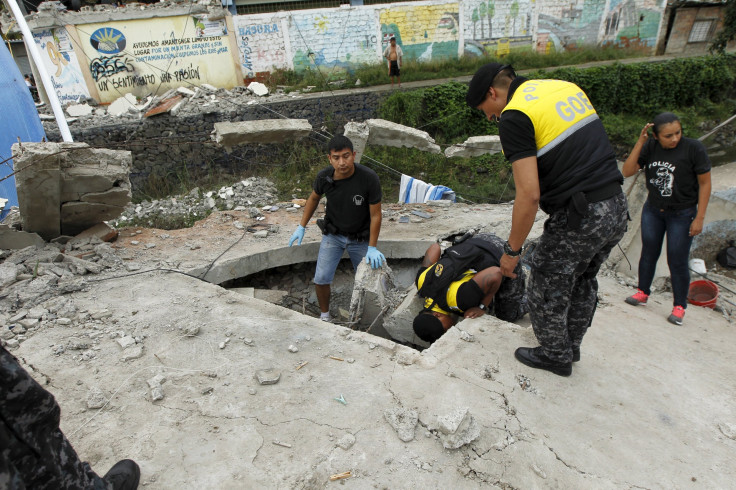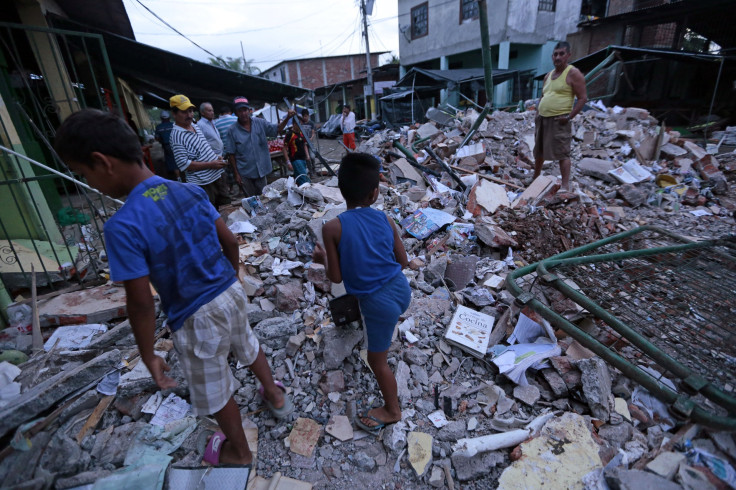Ecuador Earthquake: Death Toll Soars, Aftershocks Reported

UPDATE: 11 p.m. EDT — The death toll from Saturday’s earthquake in Ecuador continued to rise Sunday, to 262, as survivors created makeshift coffins to bury loved ones, lined up for water and sought shelter beside the rubble of their shattered homes, Reuters reported.
President Rafael Correa, who rushed home from a trip to Italy, said on Twitter, "The immediate priority is to rescue people in the rubble.’ he said on Twitter.
UPDATE: 7:30 p.m. EDT — The death toll from Ecuador's biggest earthquake in decades soared to at least 246 on Sunday as rescuers using tractors and bare hands hunted desperately for survivors in shattered coastal towns, Reuters reported.
UPDATE: 11:45 a.m. EDT — Authorities in Ecuador Sunday raised the death toll from a late night earthquake to 233 as rescuers dug through the rubble for survivors, Reuters reported. The tremor caused panic in Quito though the epicenter was more than 100 miles away.
“The immediate priority is to rescue people in the rubble,” President Rafael Correa said on Twitter as he rushed home from a trip to Italy. More than 1,500 people were injured.
Coastal town were devastated by the 7.8-magnitude quake and states of emergency were declared in six provinces.

“There are villages totally devastated,” Pedernales Mayor Gabriel Alcivar said on local radio. “What happened here in Pedernales is catastrophic.”
More than 13,000 security personnel have been mobilized to keep order.
Original Story:
At least 77 people were killed and over 500 injured after a 7.8 magnitude earthquake shook coastal Ecuador Saturday, reports said Sunday. A state of emergency was declared in six provinces and the National Guard was mobilized as the country faced 55 aftershocks, with the biggest one measuring 5.4.
Vice President Jorge Glas announced the latest death toll and added that 588 people had been injured so far, according to the BBC. He also said that the number could increase as many affected areas had not been reached. The earthquake is the largest the country has seen in decades. Streets were covered in rubble while many buildings were either partially cracked or destroyed.
In Guayaquil, one of the affected cities, security guard Fernando Garcia said, according to Reuters: “It was terrifying, we were all scared and we're still out in the streets because we're worried about aftershocks,” adding: “Everything is damaged.”
Ecuador’s President Rafael Correa cut short his trip to the Vatican to coordinate rescue efforts, and declared a national emergency. “Everything can be rebuilt, but lost lives cannot be recovered, and that's what hurts the most,” Correa told the country’s state television channel, adding: “The material part is the least important, what is fundamental is guaranteeing human life.”
The U.S. Geological Survey said, according to BBC, that the earthquake struck a shallow depth of 19.2km (11.9 miles), over 16 miles from Muisne, a sparsely populated area on the northwestern coast. An airport tower was also destroyed due to the tremors.
Ramon Solorzano, a resident of Manta city, told Reuters: “Most people are out in the streets with backpacks on, heading for higher ground,” adding: “The streets are cracked. The power is out and phones are down.”
According to a report by the Associated Press (AP), the Pacific Tsunami Warning Centre issued a statement saying that a tsunami threat warning issued earlier had passed. The statement also said that the remaining risk had to be evaluated by local authorities. Neighboring country Peru also issued a tsunami alert for its northern coastline.
Parts of the capital city of Quito were left without electricity, and BBC reports said, citing locals, that a big oil refinery was temporarily shut down as a precautionary measure. The areas worst-affected include Pedernales, a major tourist destination in the country, and Cojimies.
“There are villages that are totally devastated,” Pedernales mayor Gabriel Alcivar said, according to Reuters, adding: “What happened here in Pedernales is catastrophic.”
© Copyright IBTimes 2024. All rights reserved.






















